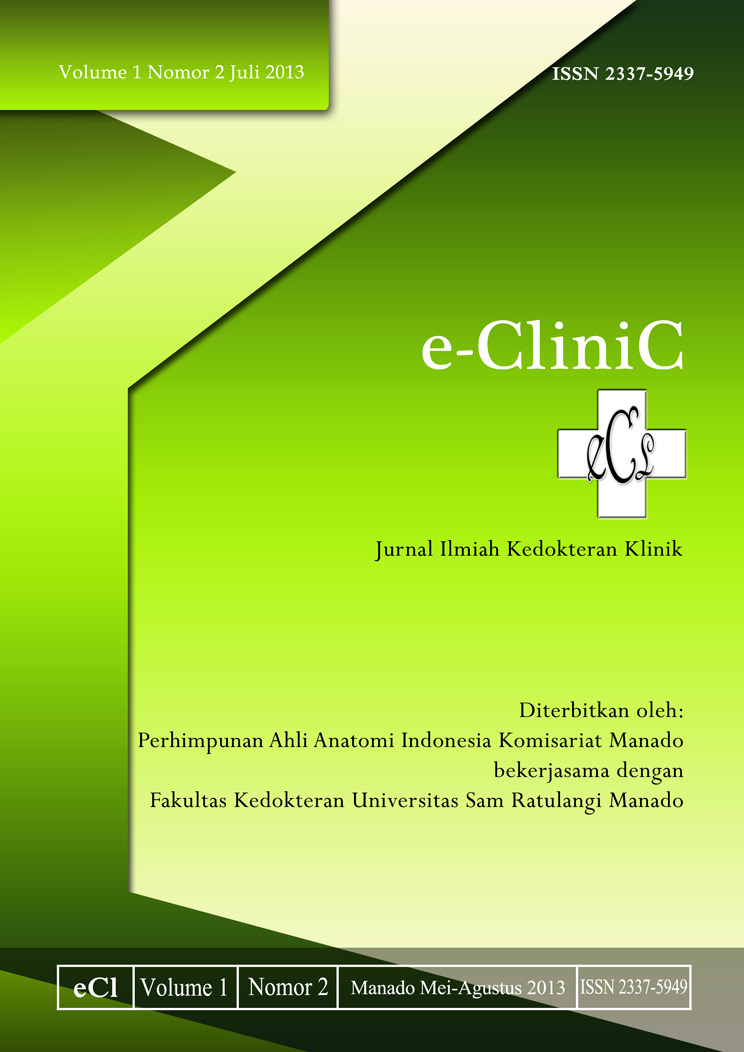HUBUNGAN OBESITAS UMUM DAN OBESITAS SENTRAL DENGAN PENYAKIT JANTUNG KORONER PADA PASIEN DI BLU/RSUP. PROF. DR. R. D. KANDOU MANADO
DOI:
https://doi.org/10.35790/ecl.v1i2.3284Abstract
Abstrak: Penyakit jantung koroner (PJK) merupakan penyakit kardiovaskuler yang menyebabkan kematian nomor satu di dunia. Awalnya obesitas dianggap sebagai faktor yang memberikan kontribusi pada risiko penyakit PJK melalui faktor lain berhubungan seperti hipertensi, dislipidemia, namun telah dibuktikan juga bahwa distribusi jaringan lemak berpengaruh pada tingginya risiko penyakit jantung koroner. Obesitas ditentukan berdasarkan indeks massa tubuh (IMT) dan lingkar pinggang. Tujuan Penelitian ini adalah peneliti ingin mengetahui hubungan IMT dan lingkar pinggang penderita PJK di BLU/RSUP. Prof. Dr. R. D. Kandou Manado. Penelitian ini bersifat pengamatan analitik dengan disain potong lintang. Populasi ialah pasien dengan penyakit jantung koroner di poliklinik Jantung BLU/RSUP Prof. Dr. R. D. Kandou Manado selama periode November 2012 yang memenuhi kriteria inklusi dan eksklusi sehingga diperoleh besar sampel 62 pasien. Sampel dipilih berdasarkan accidental sampling method. Menurut analisis univariat pasien yang mengalami PJK sebanyak 82,3% dari total sampel dan 86,7% penderita PJK tergolong memiliki lingkar perut dan IMT diatas normal. Hasil pengujian bivariat dengan kai-kuadrat dengan nilai kritis kemaknaan 0,05 didapatkan nilai p= 0,367 untuk kategori IMT dengan PJK dan nilai p= 0,135 untuk lingkar perut. Keduanya menunjukkan hubungan yang tidak signifikan. Dari penelitian ini ialah menunjukkan tidak ada hubungan yang signifikan antara obesitas umum dan obesitas sentral dengan PJK pada pasien di poli jantung BLU/RSUP Prof. Dr. R. D Kandou Manado periode November 2012.
KataKunci : Obesitas, Lingkarperut, Penyakit Jantung Koroner
Â
Â
Abstract: Coronary heart disease (CHD) is cardiovascular disease that the first causes of death in the world. Obesity was initially considered as a factor that contributes to the risk of CHD by other factors related such as hypertension, dyslipidemia, but has also proved that the distribution of fat tissue effect on the high risk of coronary heart disease.Obesity is defined by body mass index (BMI) and waist circumference. Purpose of this study the researchers wanted to know the relationship of BMI and waist circumference of patients with CHD in BLU/RSUP. Prof. Dr. R. D. Kandou Manado. The observation of this study is cross-sectional analytical design. The population was patients with CHD at the cardiac ward in the clinic of internal medicine BLU/RSUP Prof. Dr. R. D. Kandou Manado hospital during the period November 2012 that met the inclusion and exclusion criteria in order to obtain a sample size of 62 patients. Samples were selected based on accidental sampling method. According to univariate analysis of patients with CHD as much as 82.3% of the total sample, and 86.7% of patients classified as having CHD abdominal circumference and BMI above normal. Bivariate test results with kai-squared significance the critical value 0.05 obtained for p = 0.367 BMI categories with CHD and p = 0.135 for waist circumference, both showed no significant relationship. The conclusion of this study is to show there is no significant relationship between general obesity and central obesity and coronary heart disease in patients with CHD in the heart of poly BLU/RSUP Prof. Dr. R. D. Kandou Manado November 2012 period.
Keywords: Obesity, Abdominal Circumference, Coronary Heart Disease
Downloads
How to Cite
Issue
Section
License
COPYRIGHT
Authors who publish with this journal agree to the following terms:
Authors hold their copyright and grant this journal the privilege of first publication, with the work simultaneously licensed under a Creative Commons Attribution License that permits others to impart the work with an acknowledgment of the work's origin and initial publication by this journal.
Authors can enter into separate or additional contractual arrangements for the non-exclusive distribution of the journal's published version of the work (for example, post it to an institutional repository or publish it in a book), with an acknowledgment of its underlying publication in this journal.
Authors are permitted and encouraged to post their work online (for example, in institutional repositories or on their website) as it can lead to productive exchanges, as well as earlier and greater citation of the published work (See The Effect of Open Access).







